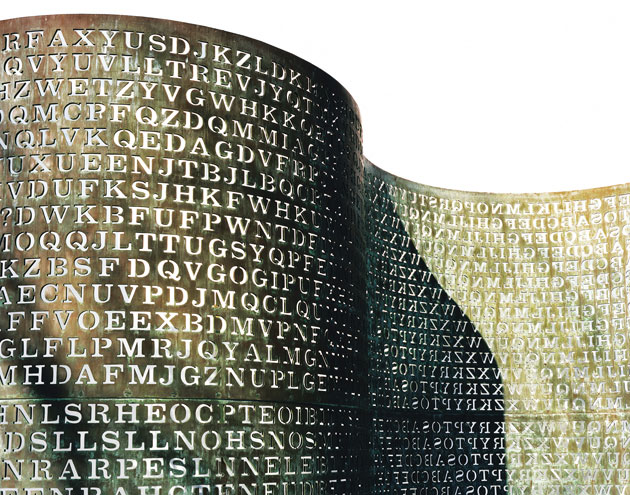
The most celebrated inscription at the Central Intelligence
Agency'sheadquarters in Langley, Virginia, used to be the biblical
phrase chiseled into marble in the main lobby: "And ye shall know
the truth, and the truth shall make you free." But in recent years,
another text has been the subject of intense scrutiny inside the
Company and out: 865 characters of seeming gibberish, punched
out of half-inch-thick copper in a courtyard.
It's part of a sculpture called Kryptos, created by DC artist James
Sanborn. He got the commission in 1988, when the CIA was
constructing a new building behind its original headquarters.
The agency wanted an outdoor installation for the area between
the two buildings, so a solicitation went out for a piece of public
art that the general public would never see. Sanborn named his
proposal after the Greek word for hidden. The work is a meditation
on the nature of secrecy and the elusiveness of truth, its message
written entirely in code.
Almost 20 years after its dedication, the text has yet to be fully
deciphered. A bleary-eyed global community of self-styled
cryptanalysts—along with some of the agency's own staffers—has
seen three of its four sections solved, revealing evocative prose
that only makes the puzzle more confusing. Still uncracked are the
97 characters of the fourth part (known as K4 in Kryptos-speak).
And the longer the deadlock continues, the crazier people get.
Whether or not our top spooks intended it, the persistent opaqueness
of Kryptos subversively embodies the nature of the CIA itself—and
serves as a reminder of why secrecy and subterfuge so fascinate us.
"The whole thing is about the power of secrecy," Sanborn tells me
when I visit his studio, a barnlike structure on Jimmy Island in
Chesapeake Bay (population: 2). He is 6'7", bearded, and looks a bit
younger than his 63 years. Looming behind him is his latest work in
progress, a 28-foot-high re-creation of the world's first particle
accelerator, surrounded by some of the original hardware from the
Manhattan Project. The atomic gear fits nicely with the thrust of
Sanborn's oeuvre, which centers on what he calls invisible forces.
With Kryptos, Sanborn has made his strongest statement about what
we don't see and can't know. "He designed a piece that would resonate
with this workforce in particular," says Toni Hiley, who curates the
employees-only CIA museum. Sanborn's ambitious work includes
the 9-foot 11-inch-high main sculpture—an S-shaped wave of copper
with cut-out letters, anchored by an 11-foot column of petrified
wood—and huge pieces of granite abutting a low fountain. And
although most of the installation resides in a space near the CIA
cafeteria, where analysts and spies can enjoy it when they eat
outside, Kryptos extends beyond the courtyard to the other side
of the new building. There, copper plates near the entrance bear
snippets of Morse code, and a naturally magnetized lodestone sits
by a compass rose etched in granite.



